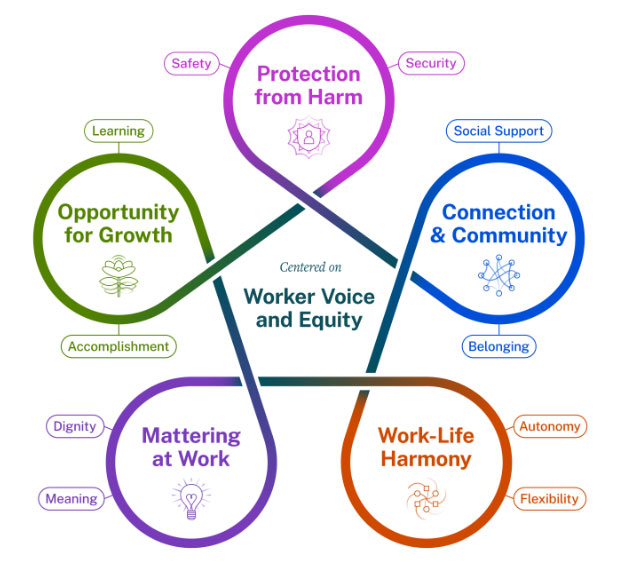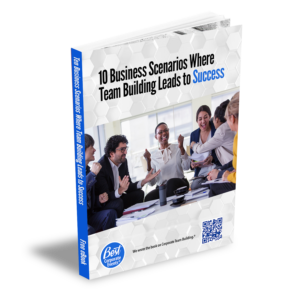Every enterprise today has access to technology, information, capital, and even talent (though they may have trouble retaining it). So what is it that separates high-performing organizations—those able to retain and engage the best people, and operate at a consistently high level—from their struggling peers? Recent research studies from Harvard and the U.S. Surgeon General agree on the answers.
Two closely related workplace factors have an outsized impact on organizational performance: relationships in the workplace and workplace wellbeing. These intertwined elements have huge effects on employee satisfaction and engagement as well as team communication and collaboration, all of which are critical ingredients in the high-performance mix.
Here’s a closer look at the research, the elements of workplace wellbeing, and how team building and professional development can help organizations improve in these areas to ultimately perform at higher levels.
The Value of Relationships in the Workplace
Harvard Business Review reports that workplace friendships are anything but trivial: “By fueling our basic human psychological need for belonging, meaningful workplace connections drive many of the outcomes central to high-performing teams…Employees with close connections at work are more productive, creative, and collaborative. They also report being more satisfied with their job, are less susceptible to burnout, and are less likely to leave their organization to pursue another role. In other words, not only are they better contributors, they provide more stability to a team.”
Relationships have far more value than just their contribution to employee retention. They are the secret to happiness. As Inc. magazine notes, “Personal connection creates mental and emotional stimulation, and those things are automatic mood boosters, while isolation is a mood buster. Humans are an intensely social species.”
The Inc. article goes on to explain how modern technology, for all of its benefits, plays a big role in increasing isolation. Technology is vital to high business and operational performance. But to optimize both performance and employee happiness (which are closely linked), organizations have to foster human connections as well.
The Elements of Workplace WellBeing
Based on extensive research, the Surgeon General has created a framework for workplace mental health and wellbeing, including five crucial elements to workplace wellbeing. In introducing the framework, the Surgeon General’s website states, “Work affects both our physical and mental well-being—in good ways and bad. (In recent surveys) 84% of respondents said their workplace conditions had contributed to at least one mental health challenge (while) 81% of workers reported that they will be looking for workplaces that support mental health in the future.
“These five essentials support workplaces as engines of well-being…Creating a plan to enact these practices can help strengthen the essentials of workplace well-being.”
Note that relationships in the workplace (Connection & Community) are one of the five critical components in the model, working with and supporting the other elements.

The Role of Team Building and Professional Development in Workplace Wellbeing
Obviously, applying this model in the workplace requires many things: leadership, executive buy-in and commitment, investment, and creativity among them.
Team building and professional development programs can also play vital roles in enhancing relationships in the workplace as well as the four other elements in the Surgeon General’s model. Here are the five elements of workplace wellbeing and how they can be impacted by team building strategies:
-
Protection from Harm
Physical security is a big consideration of course, particularly given recent stories ranging from rude restaurant patrons to abusive air travelers.
But psychological security is also crucial to workplace wellbeing and mental health. Effective Emotional Intelligence Training workshops help participants better understand their own emotions and the emotions of others to manage them constructively. The application of emotional intelligence at work helps create a culture of trust, loyalty, enhanced social awareness, and honest and open communication.
Conflict in the workplace is unavoidable, but Conflict Resolution Training teaches participants strategies to handle disagreements with respect and professionalism. Finally, DiSC Profile Workshop and MBTI Training enable employees to better understand their own personalities and recognize key traits in others, to eliminate bad habits, minimize conflict, and improve communication.
-
Connection & Community
As noted in a previous post here about how team building jumpstarts employee morale, every team building program incorporates four fundamental pillars: communication, collaboration, problem-solving, and leadership. Those pillars help employees build and enhance relationships in the workplace by working together to solve problems in a fun and challenging way, outside the normal context of work.
Corporate social responsibility (CSR) programs specifically, in addition to incorporating those pillars, create a connection between the workplace and the wider community. Working together at events that benefit deserving nonprofits creates an emotionally powerful bond and shared experience among employees.
-
Work-Life Harmony
So many factors play into healthy work-life balance, from management to company policy to workplace structure.
Team building also can also play a role in fostering this harmony. According to Roy Charette, a leader in the fields of team building and professional development training, and managing partner at Best Corporate Events, the takeaways from corporate team building that transfer to life outside of work help bridge that gap.
“When a team building activity really resonates with a participant, the lessons they experience are often the ‘24/7’ variety in that they apply to all aspects of both personal and professional life. Enhanced active listening or conflict resolution skills, for example, will transcend the workplace and brighten interactions at home with friends and family.
“Participants will sometimes feel so connected to the lessons from a particular activity that they want to replicate that experience with their family, church group, or other organization they are associated with. It reminds them of a struggle they are having or a problem they need to solve outside of work.”
-
Mattering at Work
Team building impacts this component of workplace wellbeing in a couple of different ways. First, CSR activities help employees see a larger purpose in their work. They see their organizations making an investment in giving back to the community—whether it’s a Bike Build Donation® or Bears and Blankets program to help kids or a Build-a-Wheelchair® activity to help seniors, veterans, and others with mobility impairment—and are powerfully impacted by the opportunity to play a part in that.
Second is the feeling these activities create in terms of making a difference. For the sake of mental health and well-being, employees need to feel a purpose larger than just crossing items off an (often ever-expanding) to-do list.
What precisely will make employees feel like they’ve made a difference will vary among people. It may be making a difference for customers or clients. For some workers, it’s about making a difference in helping out their team. For others, it may be taking on a big challenge that no one has been able to figure out, or becoming the go-to subject matter expert in a certain area.
“What’s great about the programs at Best Corporate Events,” says team development professional Steve Ockerbloom, “is there are so many different team building activities that help accomplish those goals, that help employees connect the exercise to their regular work and feel that sense of making a difference.
“In a program like Crack the Case!, groups of employees compete to solve a series of puzzles and challenges designed to test creative thinking, problem-solving, ingenuity, and deductive reasoning, in order to ultimately crack the case before competing teams.
“CSR programs like Build-a-Guitar® and the Mini-Golf Build Food Donation present challenges that produce a sense of accomplishment as well as giving back to the community. So if we think about meaningful work in terms of being purpose-driven, or solving challenges that seem impossible, or becoming the subject matter expert, these team building activities give people an opportunity to latch onto that aspect, which can be incredibly motivating.”
-
Opportunity for Growth
Performance coaching and feedback isn’t just for helping struggling employees get up to standard and feel like they are contributing what’s expected. It’s vital to also apply this to top performers to help them understand their opportunities and perform at an even higher level.
“Development coaching” is a skill taught in our Managers Guide to Business Coaching program. It will look different for every employee. For some, it will be about preparing them for a leadership role. Other employees may not be interested in a supervisory position, but will want to learn a new skill set, or make a lateral move to gain experience in a different part of the organization, or get involved in a new project. The key is to provide employees with a path to growth within the organization—rather than watching them walk out the door for a new job offer.
One more key point here: leadership training isn’t just for current or aspiring leaders. It can benefit virtually every employee. Attending our personality assessment workshops or other professional development programs can help employees understand different perspectives and learn techniques and insights to influence peers within the organization, even without taking on a management role.
Building High-Performing Teams through Workplace Wellbeing & Relationships in the Workplace
Studies from Harvard and other sources show that developing strong workplace relationships helps employees be more productive, collaborative, engaged, and happy at work, all of which contribute to higher levels of organizational performance.
The sense of connection produced by those strong relationships with coworkers is one of five essentials in the Surgeon General’s framework for workplace mental health and well-being. The other essentials identified in this model include a sense of safety and security, work-life harmony, a sense of mattering at work, and opportunities for advancement.
Implementing the full model requires top-level leadership and commitment, investments, and creativity. Team building and professional development programs can also play a strong supporting role in all of these facets of workplace wellbeing, ultimately leading to greater employee retention and engagement, and improved operational performance. Contact Best Corporate Events for corporate team building activities that your employees and organization will benefit from.


